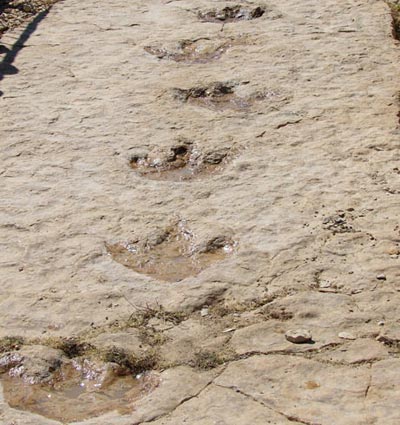Traces of dinosaurs are rare in the Arabian Peninsula
More than hundreds of dinosaur footprints have been discovered on the Arabian Peninsula, where similar fossils are extremely rare.
This 150 million-year-old trace belongs to ornithopods and sauropods - two-legged and four-legged herbivores - in modern-day Yemen.
According to the main author of the project Anne Schulp, paleontologist at Maastricht Museum of Natural History, Netherlands, 'The first day at the site we had a group of 11 sauropods and over a hundred footprints. . This provides the first data point, at least in trace terms from here. '
The traces were first discovered by Mohammed Al-Daheri, a Yemeni journalist, 50km north of Yemen's capital San'a '. The journalist informed Mohammed Al-Wosabi, a paleontologist at San'a University '. AL-Wosabi contacted colleagues abroad, including Schulp. She visited this area in December 2006.
A relaxing stroll
These footprints are a good example of herd behavior along the flat mudflats near the coast at the end of the Jurassic period, which lasted about 200 to 150 million years ago.
Paleontologists can also infer the size, age and speed of sauropods based on their footprints.'We have both young and mature dinosaurs - or at least the big one and the baby - in the same flock. What's interesting here is that they're moving together at the same speed - like a relaxing stroll. '

Recent footprints discovered in Yemen show a herd of herbivorous dinosaurs walking about 150 million years ago. This rare finding raises the debate as two herbivorous dinosaurs leaving this mark - ornithopods and sauropods - are said to not be mixed together. (Photo: Nancy Stevens)
According to Martin Lockley, manager and director of Denver Fossil Foot Collection, University of Colorado, who is not involved in the work, "The trail is a kind of photograph - almost like a film about live animals - while The bone tells you about the dead species. '
Lockley said that the discovery also "sparked ecological controversy," because 'common sense is that two types of herbivorous dinosaurs - ornithopods and sauropods - often do not coexist.'
'As I guess, this opens a new frontier.'
This work appeared in PLoS ONE.
Change hypothesis?
Ornithopods are thought to grow in size and quantity during the Cretaceous period, the next Jura period and last until 65 million years ago. But most of the footprints found in Yemen indicate that ornithopods have appeared earlier than people think.
According to Schulp 'It is quite large compared to the late Jurassic standard, and it tells us that large ornithopod dinosaurs may have appeared earlier than people assume until now.'
Nancy Stevens, a paleontologist at Ohio University in Athens, is the co-author of the project. She wrote in an email that 'This finding is encouraging at the point that it was thought to be the first discovery in the findings we hope to make in this part of the Arabian Peninsula.'
- Tracing dinosaur traces on Chukotka Peninsula (Russia)
- Thousands of 9000 year old giant 'kites' are scattered throughout the Middle East
- Interesting surprises in the richest and most relaxed country in the world
- Modern bird eggs have the color
- The land kept thousands of dinosaur footprints for 80 million years
- Protecting primates at Son Tra peninsula
- 10 weird, hard to imagine dinosaurs
- Find dinosaurs just as big as ... rabbits
- Mating dinosaurs before adulthood
- Discover the world's largest dinosaur footprint in Australia
- Detection of extremely rare dinosaur fossils in the UK
- Finding dinosaurs living in caves
 Discovered an ancient centipede fossil 99 million years old
Discovered an ancient centipede fossil 99 million years old Discovered bat-like dinosaurs in China
Discovered bat-like dinosaurs in China Discovered a 200-year-old bronze cannon of the coast
Discovered a 200-year-old bronze cannon of the coast Discover 305 million-year-old spider fossils
Discover 305 million-year-old spider fossils